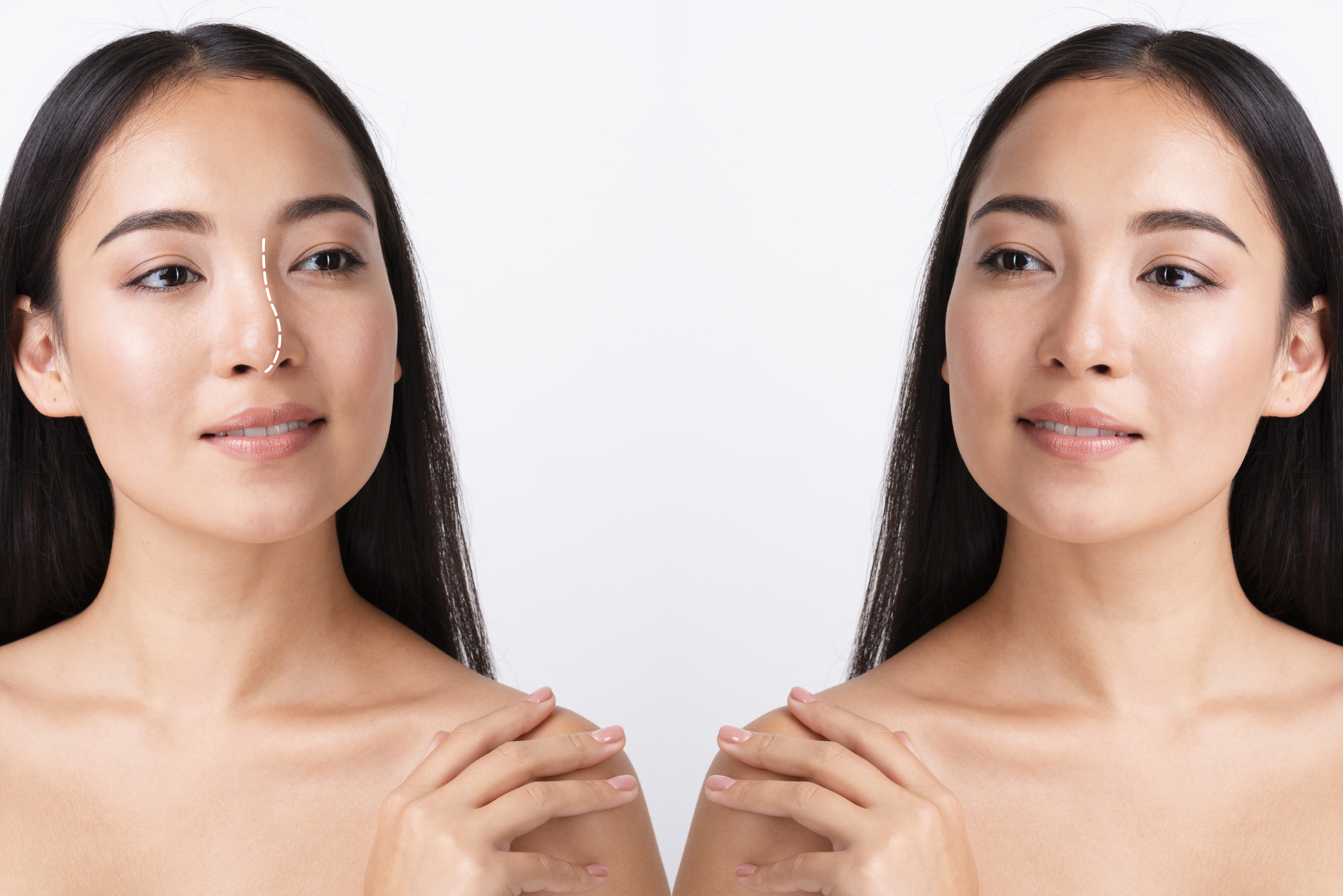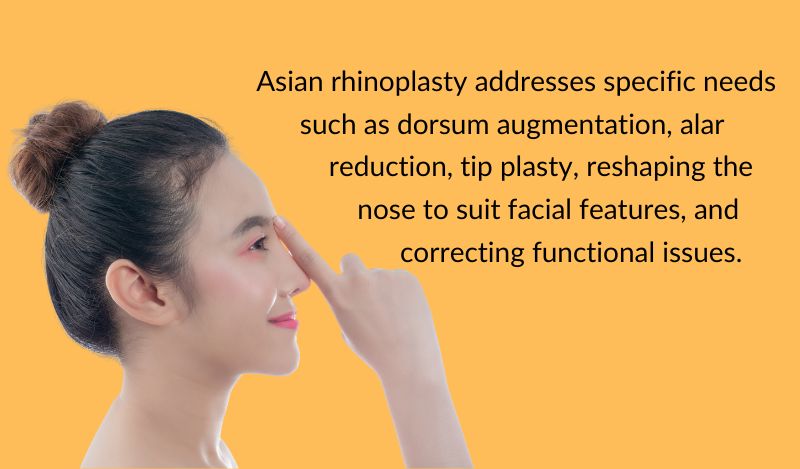Asian Rhinoplasty (Asian Nose Rhinoplasty Surgery)

Some functional or structural issues associated with the nose cause aesthetic concerns. Initially, if you have aesthetic concerns, you should identify the structural modifications you desire for your nose. Despite the absence of structural issues in the nose, you may desire a more aesthetically pleasing appearance. In all cases, it is crucial that the surgical techniques undertaken are appropriate for the ethnic facial type.
Therefore, the plastic surgeon must determine the harmony between the patient's desires and their facial characteristics and ethnic composition. There are various surgical procedures and methods that will eliminate the patient's nasal problems and meet their aesthetic needs. One of the rhinoplasty methods is "Asian rhinoplasty." So, what is the difference between Asian rhinoplasty and other rhinoplasty techniques?
What is asian rhinoplasty?

The nose structures of people of Asian origin are different from the nose types of people of other ethnic origins. Although there are changes in the nose structure according to regional differences within Asia, the Asian nose type has characteristic features.
As is well established, Asians have different facial and nasal characteristics compared to Caucasians, Westerners, or Middle Easterners. Asians typically have a flat nasal shape. The tip of the nose is also round and low. The distance between the eyes and nose is short. The nostrils are wide and splayed, and the nasal skin is thicker.
Asians are generally dissatisfied with this type of nose because they think that theirs has low projection or prominence, and they want it to have a higher bridge, narrower nostrils, and more refined nasal tips. Surgeons developed the rhinoplasty method known as 'Asian rhinoplasty' to meet these requirements. Surgeons specifically designed it for east and south Asians. This method bases its nose types on the ethnic face type, aiming to make them compatible with that face type.
What are the differences between asian rhinoplasty and other rhinoplasty methods?
First of all, Asian rhinoplasty is a unique method that differs from other rhinoplasty methods in terms of both design and applied techniques. Westerners, Middle Easterners, or Caucasians generally want to reduce the arched nose, thin or narrow the tip of the nose, and flatten the back of the nose. On the other hand, Asians prefer to elevate the nasal arch, sculpt the tip of the nose, and create the illusion of a longer or higher nose. We will explain the methods used in Asian rhinoplasty below.
In which cases is asian rhinoplasty performed?

Surgeons conduct Asian rhinoplasty to rectify functional nasal deficits (such as nasal congestion, breathing difficulties, snoring, etc.) and to meet aesthetic demands. Patients should visit a surgeon who specialises in Asian rhinoplasty in order to satisfy the needs that follow:
- Enlarging the bridge of the nose to eliminate the flat appearance (Dorsum Augmentation)
- Changing the size or shape of the nostrils (Alar Reduction)
- Having a stronger nose tip by lifting the low nose tip (Tip Plasty)
- To improve the nose profile and reshape the nose in accordance with the face type
- Eliminating functional disorders of the nose
How is Asian rhinoplasty performed?
Surgeons first determine the patient's problems with the nose. After considering the patient's wishes, the surgeon determines the appropriate procedure based on the ethnic face type. The patient undergoes some medical tests prior to the nose job. These tests determine the patient's health and morale status and determine whether the patient is suitable for a nose job. When the patient is ready for the procedures to be performed on the nose, the chosen option is applied.
Below are the procedures used in Asian rhinoplasty.
Enlarging the bridge of the nose to eliminate the flat appearance (dorsum augmentation).
To modify the flat, short, and wide appearance of Asian noses, it will be necessary to create and enlarge a prominent nasal ridge. Occasionally, nasal cartilage procedures may not be sufficient, necessitating the use of extra cartilage.
For this, augmentation methods such as synthetic implants or cartilage transplantation are used. Rib cartilage is often used for these purposes. The cartilage transplant can be obtained autologously from the patient's rib or from the rib cartilage of a cadaver. In Asian rhinoplasty, it is carefully decided which material to use, and a safe, long-lasting, and natural nose is created. These procedures are performed under general anaesthesia.
Changing the size or shape of the nostrils (Alar Reduction).
Patients often undergo alarplasty procedures to reduce and narrow the nostrils or wings. To narrow the wide nasal wings, a small amount of soft tissue is removed and the nasal wings are reshaped. Alarplasty preserves the overall structure of the nose and offers a natural and harmonious facial appearance. This procedure is performed under local anaesthesia.
Having a stronger nose tip by lifting the low nose tip (Tip Plasty).
Asian people have larger and rounder nasal tips and lower nasal tips. Graft or cartilage is used to raise the dorsum and root of the nose, narrow the base of the nose, increase the nasal projection, thin the tip of the nose and straighten the tip. The tip plasty procedure is performed under general anaesthesia.
To improve the nose profile and reshape the nose in accordance with the face type.
The nose is an important element of facial balance. Deformities in the nose will also negatively affect the facial appearance. Surgical procedures to be performed for a nose that is more compatible with the face type vary according to the purpose. In Asian rhinoplasty, small procedures can be performed on the nose to achieve a more balanced appearance, or the nose can be reshaped with larger procedures. Sometimes, local anaesthesia can perform small procedures without the need for extra material. However, cartilages or tissue transplantation may be required for larger procedures. These procedures are performed under general anaesthesia..
Asian rhinoplasty enhances the natural beauty of Asian faces while preserving their ethnic features by creating aesthetic nose contours
Eliminating functional disorders of the nose
Weak nasal septum and cartilage structure in Asians causes functional problems such as nasal congestion and inability to breathe comfortably. In the doctor's examination, the underlying causes of these problems are determined. (septum deviation, enlargement of the nasal flesh inside the nose, narrowing or collapse of the structures located in the upper parts of the nose, etc.).
If there is narrowing or collapse in the structures in the upper part of the patient's nose, these structures are repaired and strengthened. If the nasal turbinates are enlarged, the problem is solved with the conchaplasty method; if there is a deviated septum, the curvature in the nose is corrected with septoplasty. Thus, the airways are opened. After the functional problems are solved, aesthetic interventions can be performed.
FAQ
Are the effects of the Asian rhinoplasty job permanent?
The results of an Asian rhinoplasty are permanent, provided the procedure is carried out by a qualified surgeon and the right materials are used.
Does functional Asian rhinoplasty normalise nasal function?
Functional rhinoplasty completely solves problems in the nose and offers permanent results. The nose satisfies its normal function. At the same time, it creates a nose profile that is aesthetically natural and harmonious with the face.
Is cadaveric rib cartilage used for Asian rhinoplasty safe?
If appropriate cadaveric cartilage is obtained and stored under appropriate conditions, it is very safe against infection and other complications.
What is the length of time of asian rhinoplasty job?
The length of asian rhinoplasty job depends on the procedures to be performed on the nose, the experience of the surgeon, and the surgical technique. The typical time of rhinoplasty is often between 2 and 4 hours.
From which location is autologous rib cartilage obtained?
A small incision under the fold of the chest can remove the patient's rib cartilage.
Which complications can develop after an Asian rhinoplasty job?
Swelling and bruising around the nose and around the eyes may occur after the operation. These symptoms are usually at their most intense in the first week and decrease over time. You may feel mild pain and discomfort for the first few days after surgery, but your surgeon will prescribe painkillers.
How is the recovery process after Asian rhinoplasty?
Firstly, a nasal splint is applied to the patient after surgery. In this way, healing tissues are protected and possible nasal traumas are prevented. The nasal splint is removed two weeks after the operation. Depending on the need, tampons can sometimes be used in the nose. Usually, the surgeon removes tampons on the 5th to 7th day of surgery.
If there are external stitches, the surgeon usually removes them 5 to 7 days after the operation. Internal sutures dissolve spontaneously.
Post-surgery, swelling is anticipated to diminish within one month. Within 1 to 3 months, the new contour of the nose becomes more pronounced, and the oedema significantly diminishes.
If the surgeon's instructions are followed, it will take at least 6 months and up to 1 year for the nose to heal completely and take its final shape. During this time, you will achieve the desired contour of your nose.
Can daily activities be performed after a nose job?
After surgery, most patients can perform light physical activities and daily work. However, heavy lifting and activities that may pose a risk of nasal impact should be avoided.
What should be considered after surgery?
It is very important to have regular medical check-ups. During this period, it is necessary to follow the doctor's recommendations completely. In addition, it should not lie face down, protect the nose from possible impacts, and pay attention to nose cleaning. If it is necessary to stay in the sun, sunscreen creams should be used.

